Clarkie’s Orkney Tour – April 2005
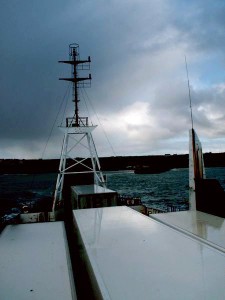 The sky looked a mite threatening as we left Gills Bay on the old Claymore. When we booked the ferry, we didn’t realise the Pentalina B was undergoing some pre-tourist-season refurbishment, and they’d brought the Claymore off the bench, as it were. She’s an ex Caledonian MacBrayne ferry, registered in Glasgow, and if I recall correctly she used to sail from Oban to Mull, Tiree and so on. I’m sure it was her I was on, when I went to Coll many years ago.
The sky looked a mite threatening as we left Gills Bay on the old Claymore. When we booked the ferry, we didn’t realise the Pentalina B was undergoing some pre-tourist-season refurbishment, and they’d brought the Claymore off the bench, as it were. She’s an ex Caledonian MacBrayne ferry, registered in Glasgow, and if I recall correctly she used to sail from Oban to Mull, Tiree and so on. I’m sure it was her I was on, when I went to Coll many years ago.
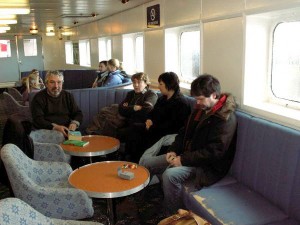 So many years ago, little wonder she’s now in semi-retirement. And little wonder I checked out the many rusty bits with some apprehension. I don’t like water at the best of times, and the Pentland Firth does have a certain notoriety. However, being tour guide for the day, I didn’t share my reservations with my friends from Aberdeenshire and France. They were engrossed in checking guidebooks and replacing batteries in cameras, and apparently quite content.
So many years ago, little wonder she’s now in semi-retirement. And little wonder I checked out the many rusty bits with some apprehension. I don’t like water at the best of times, and the Pentland Firth does have a certain notoriety. However, being tour guide for the day, I didn’t share my reservations with my friends from Aberdeenshire and France. They were engrossed in checking guidebooks and replacing batteries in cameras, and apparently quite content.
I did, of course, share my limited knowledge of the Claymore after we were home. With an Old Pulteney nightcap in their hands, and smothered by a home-alone big bouncy dog, they were fortunately unfazed by my doubts about seaworthiness.
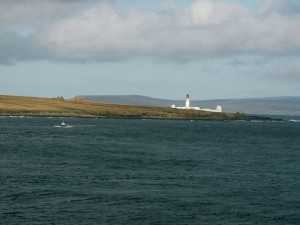 The cloud broke up a little as we passed Stroma. Stroma is uninhabited now, apart from seasonal sheep, but was a thriving island community until the last residents left in 1962. Its population peaked in 1901 at 375, but the decline begun with the downturn in the fishing economy, which was the main income source. Stroma comes from Norse, and means “The Island in the Stream”. So presumably the BeeGees, Kenny Rogers and Dolly Parton have all been here.
The cloud broke up a little as we passed Stroma. Stroma is uninhabited now, apart from seasonal sheep, but was a thriving island community until the last residents left in 1962. Its population peaked in 1901 at 375, but the decline begun with the downturn in the fishing economy, which was the main income source. Stroma comes from Norse, and means “The Island in the Stream”. So presumably the BeeGees, Kenny Rogers and Dolly Parton have all been here.
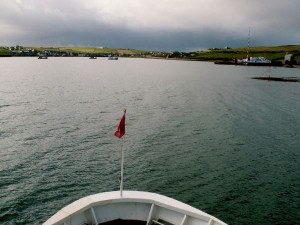 As we arrived at St Margaret’s Hope, the weather had worsened again, and we were beginning to question the wisdom of a day trip to Orkney in a Scottish April. The tour guide in his wisdom suggested we whiz past the Churchill Barriers with their visible wrecks – scuttled to block the channels into Scapa Flow during WWII – and the Italian Chapel (built by Italian POWs) and pick them up on the way back to the ferry. Likewise, I suggested only a brief stop in Kirkwall to update our information at the TIC. We could visit St Magnus Cathedral on the way back.
As we arrived at St Margaret’s Hope, the weather had worsened again, and we were beginning to question the wisdom of a day trip to Orkney in a Scottish April. The tour guide in his wisdom suggested we whiz past the Churchill Barriers with their visible wrecks – scuttled to block the channels into Scapa Flow during WWII – and the Italian Chapel (built by Italian POWs) and pick them up on the way back to the ferry. Likewise, I suggested only a brief stop in Kirkwall to update our information at the TIC. We could visit St Magnus Cathedral on the way back.
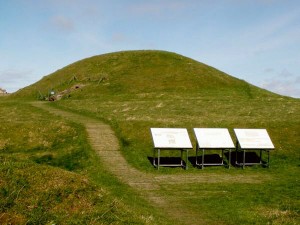 So we headed for Maeshowe, the finest chambered cairn in Western Europe, built before 2700BC and containing the largest collection in the world of runic inscriptions to be found in one place. It was shut. Albeit temporarily, for a guided tour of luminaries, but Joe Public with a ferry to catch had to move on. The day was getting better, though. The sun was shining.
So we headed for Maeshowe, the finest chambered cairn in Western Europe, built before 2700BC and containing the largest collection in the world of runic inscriptions to be found in one place. It was shut. Albeit temporarily, for a guided tour of luminaries, but Joe Public with a ferry to catch had to move on. The day was getting better, though. The sun was shining.
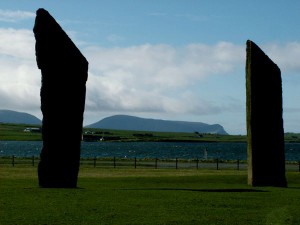 Next stop, the Standing Stones of Stenness, dating from the third millennium BC. This is what Orkney’s about, for me. It has an incredibly rich and varied pre-history.
Next stop, the Standing Stones of Stenness, dating from the third millennium BC. This is what Orkney’s about, for me. It has an incredibly rich and varied pre-history.
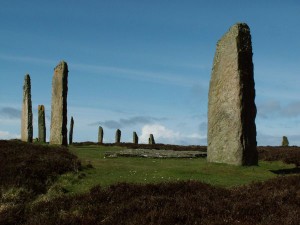 And just up the road is the Ring of Brodgar. It dates from the same period as the (perhaps) more famous Callanish, on Lewis. But for me it is equally awe-inspiring.
And just up the road is the Ring of Brodgar. It dates from the same period as the (perhaps) more famous Callanish, on Lewis. But for me it is equally awe-inspiring.
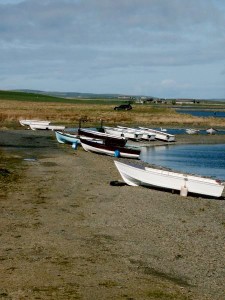 Both the Stenness Circle and the Brodgar Ring rest on the shore of Loch Harray, where anglers were standing patiently up to their oxters, and an array of wee boats on the shore promised much more fishing in more favourable weather. Today’s pastimes seem to rest easily alongside these emotive monuments of our ancestors. I guess that’s the sort of place Orkney is.
Both the Stenness Circle and the Brodgar Ring rest on the shore of Loch Harray, where anglers were standing patiently up to their oxters, and an array of wee boats on the shore promised much more fishing in more favourable weather. Today’s pastimes seem to rest easily alongside these emotive monuments of our ancestors. I guess that’s the sort of place Orkney is.

Leave a Reply